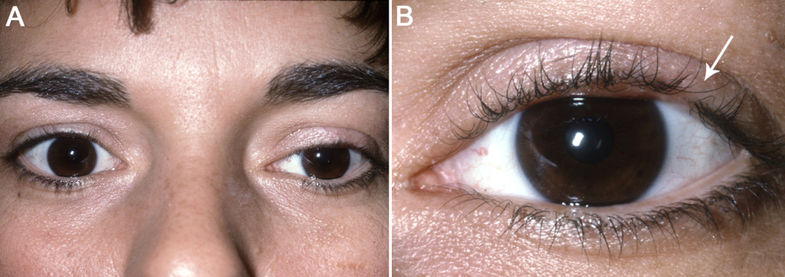Sebaceous Carcinoma Treatments from U.S. Dermatology Partners
What Is Sebaceous Carcinoma?
A rare and aggressive form of skin cancer, sebaceous carcinoma is sometimes referred to as sebaceous gland carcinoma, sebaceous gland adenocarcinoma or meibomian gland carcinoma.
Sebaceous carcinoma can develop in any sebaceous glands, which lubricate the skin, but it most often begins on or around the eyelids. If it is found and treated early, treatment is often successful. However, if sebaceous carcinoma spreads, it can be deadly.
Because sebaceous carcinoma can appear to be a benign growth such as a stye, diagnosis is often delayed, which increases the risk of death. If you notice a growth on your eyelid, it’s important to make an appointment with your dermatologist. The sooner sebaceous carcinoma is diagnosed and treated, the better the outcome.

“32-year-old cosmetologist presented with 3-month history of treatment for presumed chalazion. A) The left upper eyelid showed 2 mm of ptosis with swelling. B) Focal loss of eye lashes was appreciated (arrow).” (source: “Early Onset of Sebaceous Carcinoma” by Dr. Debashis Ghosh, creative commons license)
Find This Service Near You
Who Is at Risk for Sebaceous Carcinoma?
Although sebaceous carcinoma can affect all ages and has been seen in children as young as three, people diagnosed with this form of skin cancer are most often between 60 and 80 years of age. It’s also more commonly found in women.
Additional risk factors include:
- Unprotected sun exposure
- Radiation therapy to the head or neck, especially radiation treatments for retinoblastoma
- A weakened immune system, which can be caused by medical conditions such as cancer or human immunodeficiency virus (HIV)
- Medication to prevent the body from rejecting an organ transplant or some medications used to treat conditions such as psoriasis or arthritis
- Muir-Torre syndrome
- Asian heritage, according to some studies
Sebaceous Carcinoma Symptoms
Often discovered on the eyelid, sebaceous carcinoma can present itself as a firm, painless, slow-growing yellowish bump. It’s frequently mistaken for a stye, chalazion or pink eye, but it does not improve with standard treatments for those conditions. A growth could also look like a pimple, or it could bleed or ooze.
Additional symptoms can include:
- A sore on the eyelid that reoccurs or fails to heal
- Yellow or reddish crust along the lash line
- Thickening of the eyelid along the lash line
- Loss of eyelashes
As sebaceous carcinoma spreads, additional growths may appear, and eyesight can be affected.
Elsewhere on the body, sebaceous carcinoma frequently appears on the head or neck, but it has also been found in the ear canal and on the chest, back, abdomen, buttocks, breasts and genitals. There, it can appear as a slow-growing, yellowish or pink bump that may bleed.
Schedule an appointment with your dermatologist if you’ve had any of the above symptoms for more than two weeks.
Sebaceous Carcinoma Treatments
Most sebaceous carcinomas can be treated with surgery. Treatment options may include:
- Mohs surgery, a highly specialized technique that removes the cancerous tissue while preserving surrounding healthy tissue
- Excision or surgical removal of the tumor and some surrounding tissue
- Cryotherapy, which freezes the growth with liquid nitrogen
- Surgery to remove lymph nodes, if the cancer has spread
- Radiation, if the cancer has spread or if surgery is not an option
Because sebaceous carcinoma is an aggressive form of cancer, it’s important to treat the condition early and keep all follow-up appointments to check for recurrence. Fortunately, when found and treated early, sebaceous carcinoma has a high survival rate.
Sebaceous Carcinoma Prevention

Woman wearing a wide-brimmed hat to help protect her face from harmful UV rays.
To help prevent sebaceous carcinoma, protect your skin from sun exposure.
- Use a broad spectrum (UVA/UVB) sunscreen with an SPF of 15+ daily.
- Use a water-resistant broad spectrum (UVA/UVB) sunscreen with an SPF of 30+ during extended outdoor activity.
- Limit your time outdoors between 10:00 AM and 4:00 PM.
- Cover up with a broad-brimmed hat, UV-blocking sunglasses, long pants and a long-sleeved shirt when outside.
- Avoid tanning booths.
It’s also important to examine your skin, head-to-toe, every month and to see your dermatologist every year for an annual skin examination.
*Results may vary by individual
